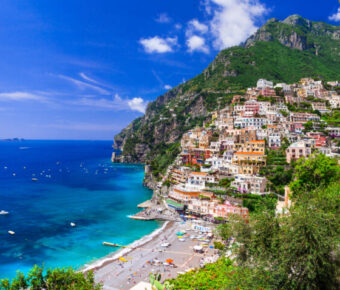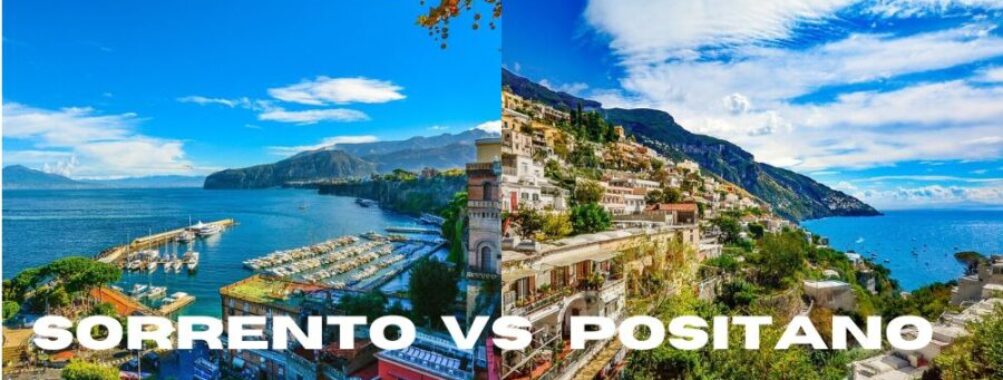
Sorrento vs Positano: Which Stunning Amalfi Coast Town is Actually Worth Your Time in 2025
Picture-perfect towns dot the Amalfi Coast of southern Italy, but Sorrento and Positano stand out as two of the most enchanting destinations. Perched on dramatic cliffs overlooking sparkling blue waters, these iconic spots offer very different experiences for travelers. Sorrento provides a more convenient, lively base with better transport links and urban amenities, while Positano delivers pure postcard charm with its pastel buildings cascading down to a pebble beach.
These two gems of the Italian coast each have their own distinct personality. Sorrento sits above the Bay of Naples, mixing historic charm with modern comforts. Its streets buzz with cafes, shops, and the scent of lemon groves. Positano clings to the mountainside along the Amalfi Coast, with narrow lanes winding past boutiques and restaurants down to the sea.
Table of Contents
- Geographic Context and Accessibility
- Location and Landscape
- Transportation and Travel Routes
- Accommodation and Lodging
- Hotels and Resorts
- Budget-Friendly Options
- Luxury Stays
- Family-Friendly Accommodations
- Culinary Delights
- Local Cuisine and Dining
- Seafood Specialties
- Restaurants and Eateries
- Limoncello Tasting
- Beaches and Coastal Charm
- Sorrento’s Shores and Beach Clubs
- Positano’s Spiaggia Grande and Fornillo
- Shopping and Leisure Activities
- Local Markets and Ceramics
- Exclusive Boutiques and Artisans
- Lemon Groves and Tours
- Nightlife and Entertainment
- Evening Scenes and Vibes
- Music and Dancing
- Romantic Spots and Views
- Cultural Experiences and Sightseeing
- Historical Sites and Ruins
- Churches and Architectural Marvels
- Museums and Galleries
- Festivals and Events
- Outdoor Adventures and Nature
- Scenic Hiking Trails
- Coastal Walks and Explorations
- Water Sports and Activities
- Planning Your Visit
- Best Time to Travel
- Travel Style and Itineraries
- Budgeting for the Trip
- Frequently Asked Questions
- What are the main differences between Sorrento and Positano in terms of tourist attractions?
- Which destination is preferable for a day trip, Sorrento or Positano, and why?
- How does the nightlife compare between Sorrento and Positano?
- From a logistical standpoint, what should one consider when choosing between staying in Sorrento or Positano?
- How do the beach experiences differ between Sorrento and Positano?
- What are the travel options for getting from Sorrento to Positano, and which is most recommended?
- Book Your Dream Experience
- More Travel Guides
Geographic Context and Accessibility
Sorrento and Positano sit along Italy’s stunning Campania coastline, with distinct geographical features that shape their character and ease of access. These coastal towns offer different experiences based on their unique locations and terrain.
Location and Landscape
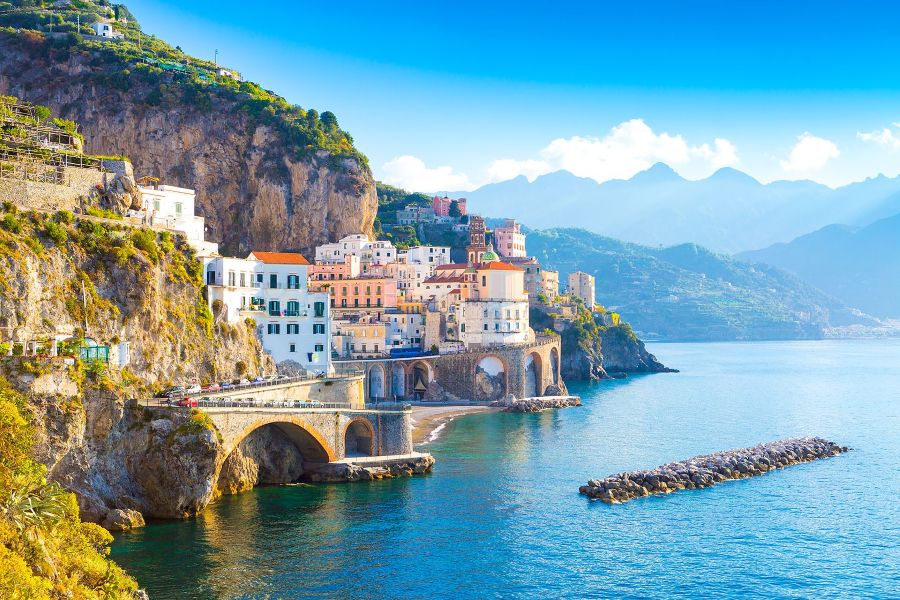
Sorrento perches on dramatic limestone cliffs above the Bay of Naples, creating stunning views of Mount Vesuvius across the water. The town spreads across a flat plateau, making it easier to walk around and explore.
Positano clings to steep cliffs along the Amalfi Coast, with colorful buildings cascading down to the Tyrrhenian Sea. The vertical landscape creates the town’s famous postcard views but also means lots of stairs and climbing.
The towns are about 10 miles apart by road, though the journey takes longer than you might expect due to the winding coastal route.
Transportation and Travel Routes
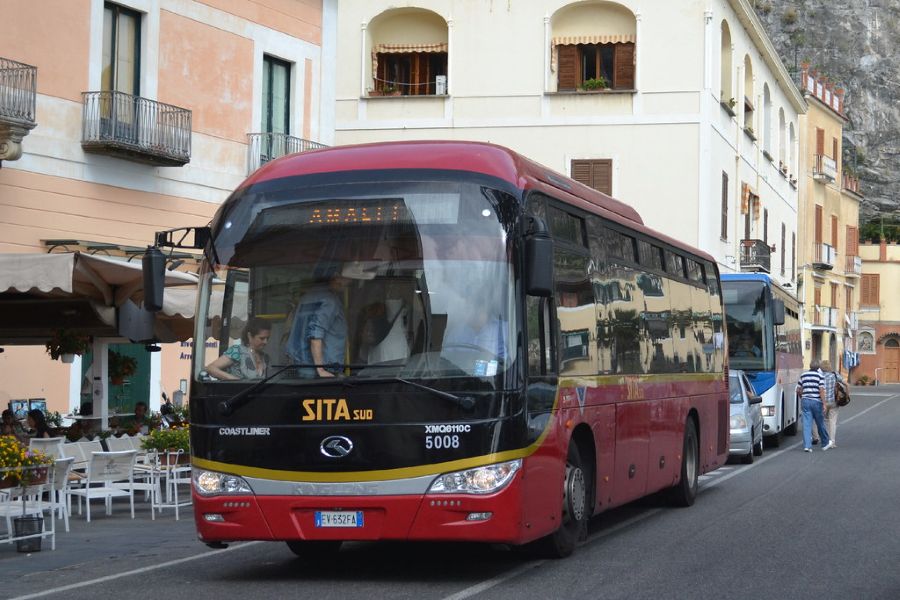
Sorrento serves as a major transport hub with excellent connections. The Circumvesuviana train links directly to Naples, and regular ferries connect to Capri and Naples from its port. Many travelers use Sorrento as a base for exploring the region by booking their travel arrangements through various services.
Positano has more limited transport options. The main access is by SITA bus along the coastal road or by private car. No train service exists, though summer ferry services connect to other coastal towns.
Driving to either town can be challenging on narrow, winding roads. Parking is easier to find in Sorrento, while Positano has very limited parking spaces that often fill up quickly.
The nearest major airport is in Naples, making Sorrento typically the first stop for many visitors since it’s closer and more accessible.
Accommodation and Lodging
Both Sorrento and Positano offer diverse places to stay, from grand cliffside hotels to cozy bed and breakfasts. The options vary greatly in price, style, and amenities.
Hotels and Resorts
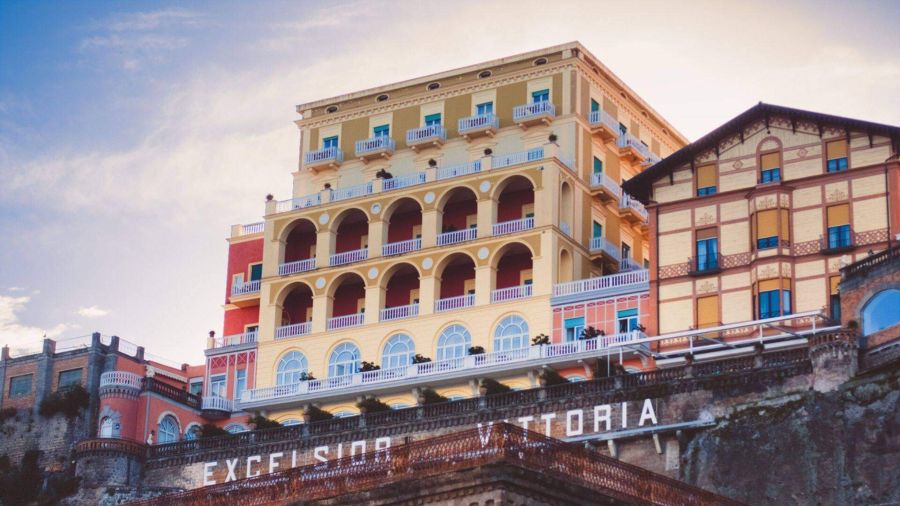
Sorrento sparkles with waterfront hotels facing the Bay of Naples and Mount Vesuvius. The Grand Hotel Excelsior Vittoria stands out with its historic architecture and stunning gardens. The Hilton Sorrento Palace brings modern luxury and spectacular views.
Positano’s hotels cling dramatically to the cliffside. Many rooms feature private balconies overlooking the sea. Le Sirenuse and Il San Pietro di Positano rank among the most famous luxury accommodations in the area.
Budget-Friendly Options

Sorrento wins for affordable stays. Many family-run hotels and B&Bs charge reasonable rates, especially in the town center. Hotel Nice and Hotel Tourist offer clean rooms at good prices.
Positano’s budget choices are limited. A few guesthouses and small hotels sit higher up the hill, away from the beach. These rooms cost less but require more walking.
Prices in both towns drop from November through March. Book early to grab the best deals.
Luxury Stays
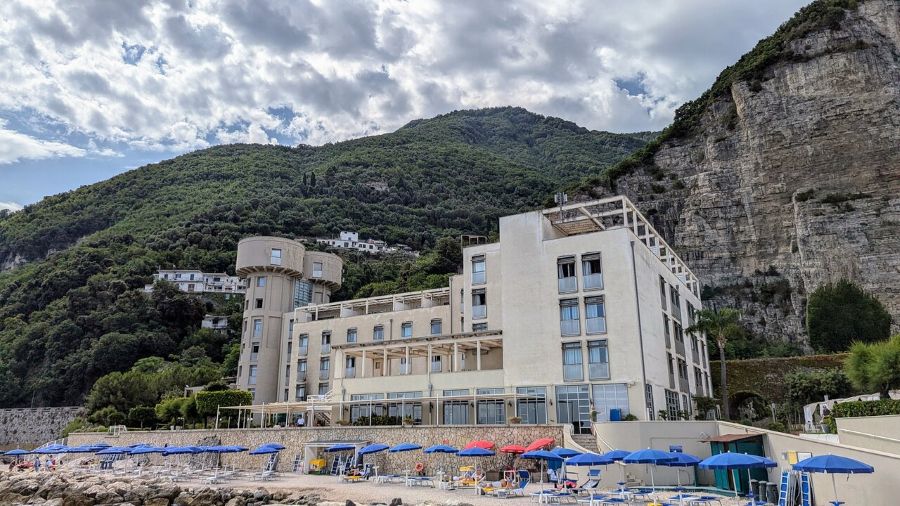
Positano excels in high-end hotels. Most luxury properties feature infinity pools, spa services, and Michelin-starred restaurants. Room rates often start at €500 per night.
The best suites come with massive terraces and personal butler service. Many celebrities choose these exclusive hideaways for privacy and glamour.
Sorrento’s luxury hotels tend to be more classical in style. They emphasize old-world charm and elegant service.
Family-Friendly Accommodations
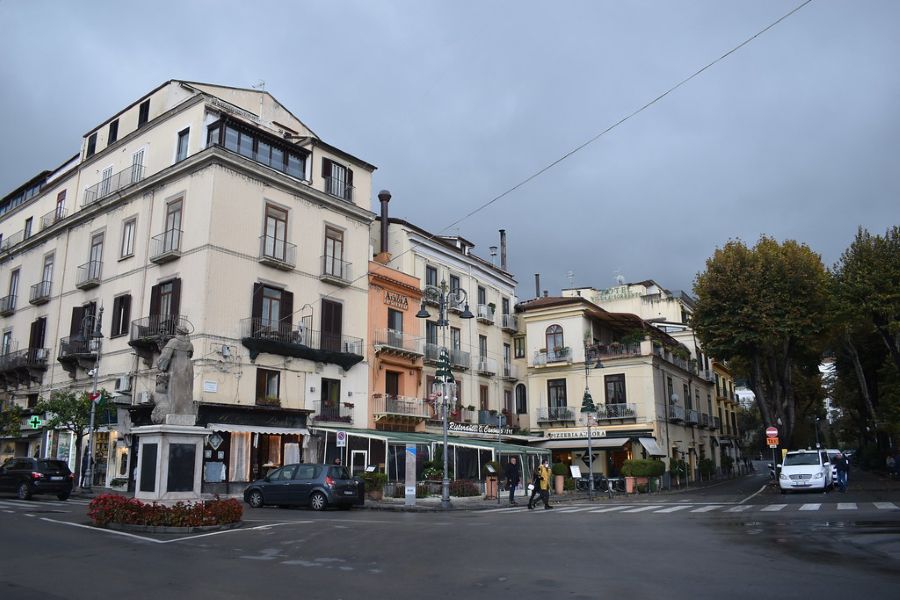
Sorrento offers more options for families. Many hotels have large rooms, kids’ pools, and special meal plans. The Grand Hotel La Favorita and Hotel Continental provide excellent amenities for children.
Properties near Piazza Tasso give easy access to gelato shops and family restaurants. Some hotels offer babysitting services and children’s activities.
Positano’s steep stairs make it trickier with kids. A few hotels provide shuttle services to help families get around town.
Culinary Delights
Both Sorrento and Positano offer incredible food experiences that showcase the best of Italy’s coastal cuisine. Each town brings its own unique flavors to the table, from fresh-caught seafood to locally-made cheeses and citrus-based treats.
Local Cuisine and Dining

Sorrento’s food scene centers around traditional cheese products that locals have perfected over generations. The star attractions include smoked provola, treccia (braided mozzarella), and the famous provolone del monaco cheese. Many restaurants offer cooking classes where visitors can learn to make gnocchi alla sorrentina – a cheesy potato pasta dish.
The streets burst with family-run trattorias serving classic dishes like eggplant parmigiana and handmade pasta with fresh tomato sauce.
Positano takes a simpler approach, focusing on fresh ingredients and seafood-based recipes passed down through families. Small restaurants tucked into the hillside serve traditional dishes like scialatielli pasta with local clams.
Seafood Specialties

Positano’s waterfront location makes it a paradise for seafood lovers. The morning catch brings in fresh octopus, prawns, and local fish species that go straight to restaurant kitchens.
Signature dishes include:
- Zuppa di cozze (mussel soup)
- Grilled sea bass with lemon
- Seafood risotto with local shrimp
- Spaghetti alle vongole (with clams)
Sorrento also serves excellent seafood, but puts unique twists on classic dishes by incorporating local cheese and citrus flavors.
Restaurants and Eateries
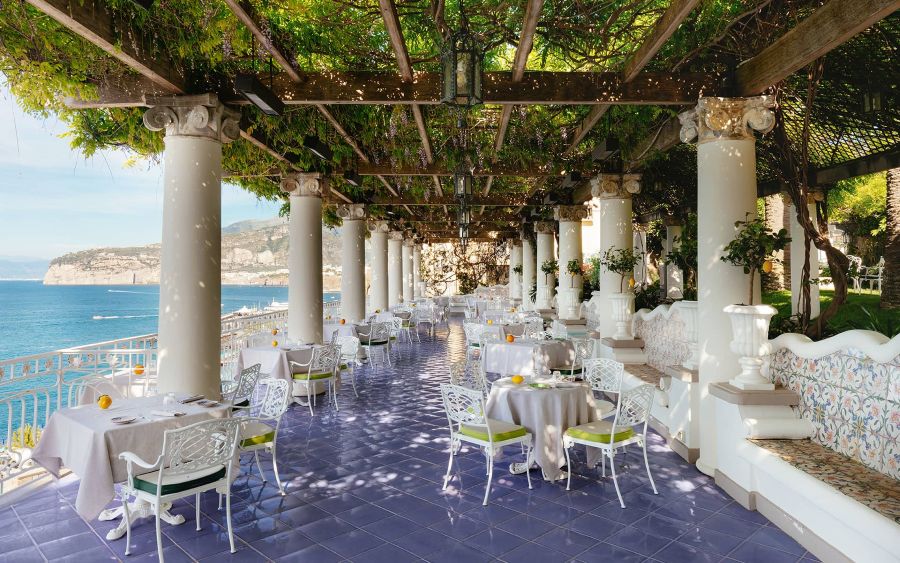
Small, family-owned restaurants fill both towns. In Sorrento, many cluster around Piazza Tasso and the historic center. Top spots feature terraces with views over the Bay of Naples.
Positano’s restaurants cascade down the hillside, offering stunning views with dinner. Many require reservations, especially during peak season. The most sought-after tables are at the waterfront establishments.
Some restaurants host wine tastings paired with local specialties. These events let visitors sample regional wines while learning about food traditions.
Limoncello Tasting

The region’s famous limoncello starts with local Sorrento lemons, known for their intense fragrance and flavor. Small producers still make this lemon liqueur using traditional methods.
Many shops offer free tastings of their homemade limoncello. The best versions have a bright yellow color and balanced sweetness.
Visitors can tour limoncello factories in Sorrento to see the production process. These tours often include sampling different varieties and learning proper serving techniques.
Beaches and Coastal Charm
The beaches of Sorrento and Positano offer distinct coastal experiences, from dramatic rocky cliffs to soft sandy shores. Each town’s waterfront areas showcase unique features that draw visitors seeking different kinds of beach experiences.
Sorrento’s Shores and Beach Clubs
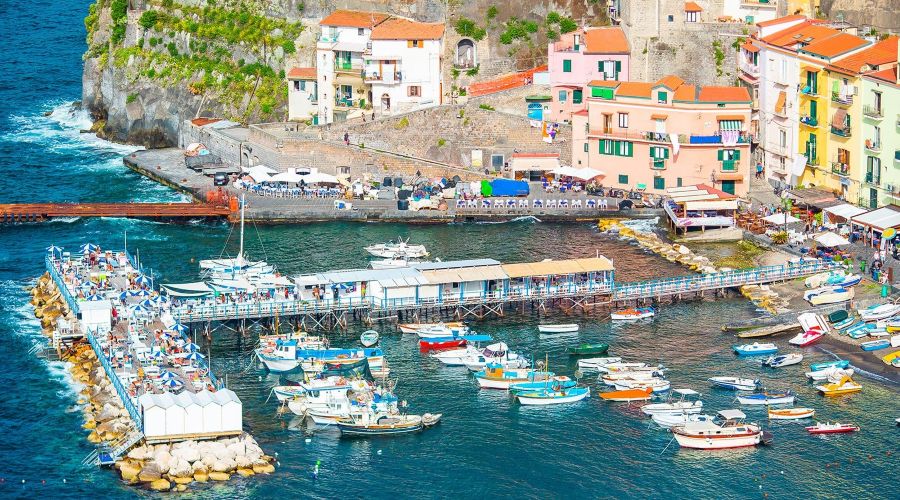
Marina Grande serves as Sorrento’s main beach area, nestled beneath towering cliffs. The pebble beaches here are smaller but less crowded than Positano’s shores. Beach clubs dot the coastline, providing comfortable loungers and umbrellas for daily rental.
The crystal-clear waters of the Bay of Naples make this spot perfect for swimming and snorkeling. Several platforms built into the rocky cliffs give sunbathers extra space to spread out.
Local fishing boats line the shore, creating a charming atmosphere that blends beach life with maritime tradition.
Positano’s Spiaggia Grande and Fornillo
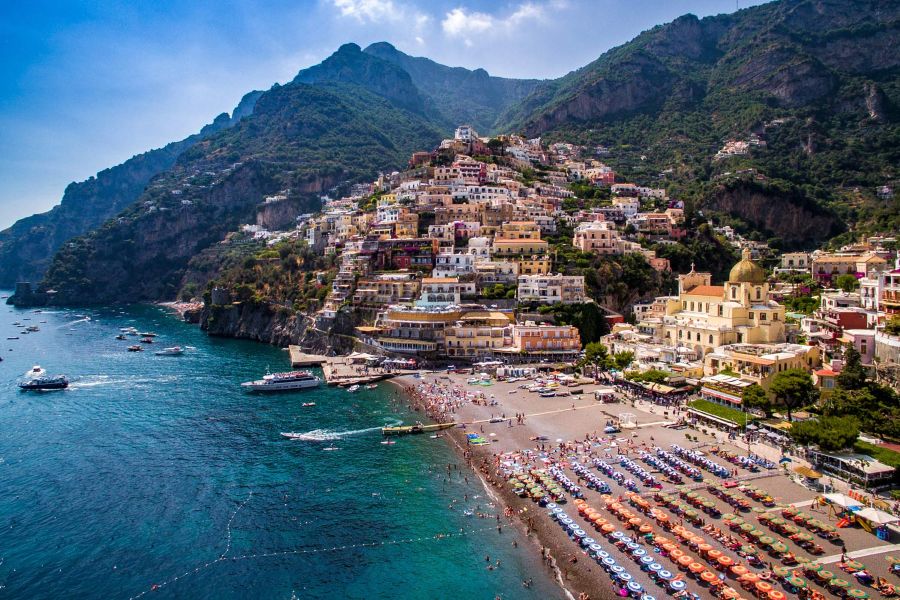
Spiaggia Grande, Positano’s main beach, stretches along the town’s base with its signature gray pebbles and clear blue waters. Colorful umbrellas and sunbeds fill the beach during warm months. The backdrop of pastel-colored houses climbing up the cliffs creates stunning photo opportunities.
Fornillo Beach sits just a 10-minute walk from Spiaggia Grande. This quieter alternative offers a more laid-back vibe and fewer crowds. The path to Fornillo follows the coastline, providing beautiful sea views.
Both beaches feature clear, shallow waters ideal for swimming. Local boat rentals let visitors explore hidden coves and nearby beaches only accessible by water.
Shopping and Leisure Activities
Shopping in these coastal towns ranges from local markets selling traditional ceramics to upscale fashion boutiques. The famous lemon groves offer unique tours and tastings of authentic limoncello.
Local Markets and Ceramics
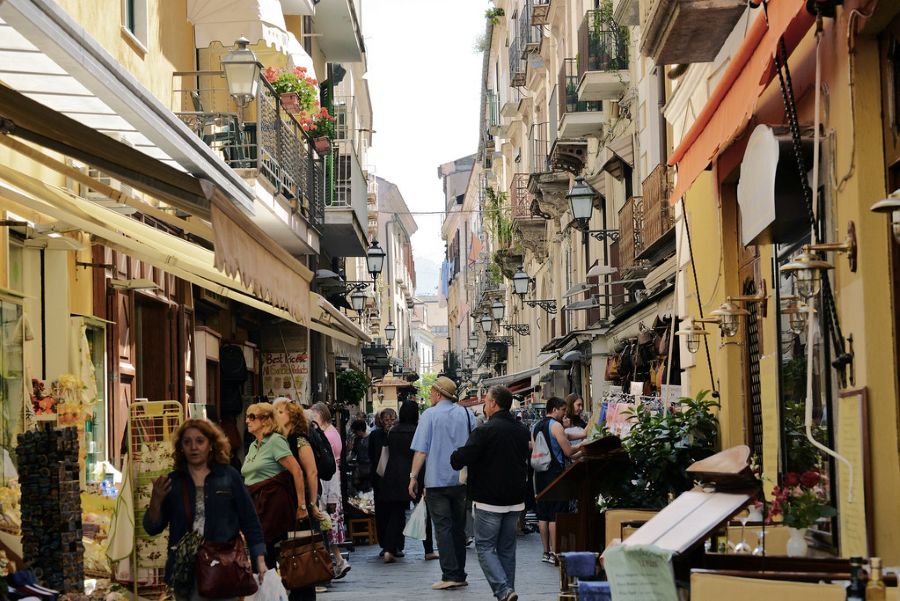
Sorrento’s markets buzz with activity, especially along Via San Cesareo. Local artisans craft stunning ceramics painted with Mediterranean colors and lemon designs. The prices here tend to be lower than in Positano.
The ceramic shops display beautiful plates, tiles, and tableware. Many pieces feature the region’s signature blue and yellow patterns that reflect the sea and citrus heritage.
Vendors at Marina Grande sell fresh seafood and local produce in the mornings. The market stalls offer a glimpse into daily Italian life away from tourist spots.
Exclusive Boutiques and Artisans
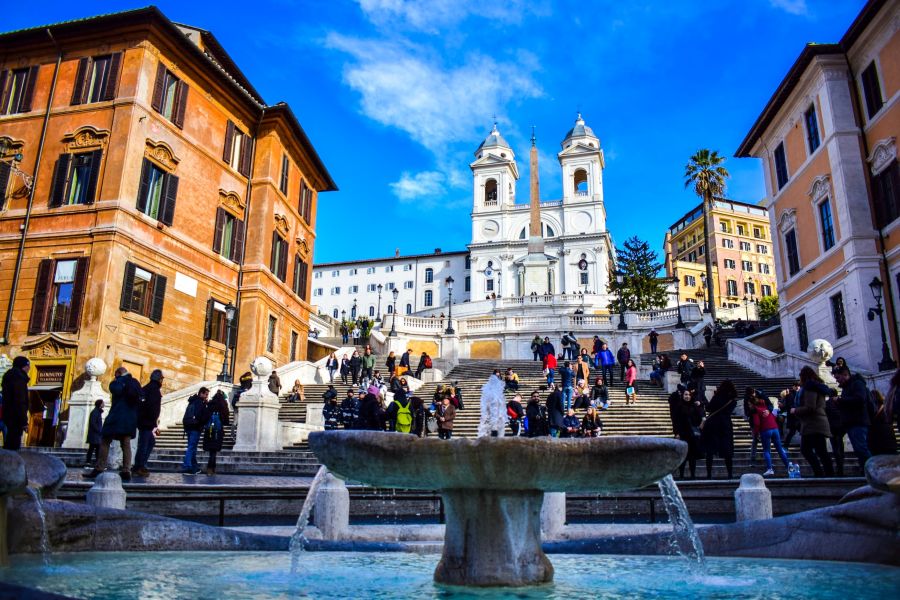
Positano’s steep streets showcase fashion boutiques and artisan workshops. The town is famous for its handmade leather sandals, with craftsmen creating custom pairs while you wait.
Local designers sell breezy linen clothing perfect for the Mediterranean climate. Many shops feature Moda Positano – the town’s signature style of colorful resort wear.
Sorrento’s Corso Italia hosts high-end stores selling designer brands. The street comes alive in evenings during the passeggiata – the traditional Italian evening stroll.
Lemon Groves and Tours

The Sorrentine Peninsula’s lemon groves produce the region’s prized citrus. Many farms offer guided tours where visitors learn about limoncello production and cultivation methods.
I Giardini di Cataldo in Sorrento welcomes guests to tour their historic groves. Visitors can taste fresh lemonade and watch limoncello being made using traditional recipes.
Small family farms around Positano arrange private tours with cooking classes. Groups learn to make limoncello and lemon-based dishes using fruit picked straight from the trees.
Nightlife and Entertainment
Sorrento and Positano treat night owls to two totally different after-dark scenes. Sorrento buzzes with energy and lots of options, while Positano keeps things low-key and romantic.
Evening Scenes and Vibes
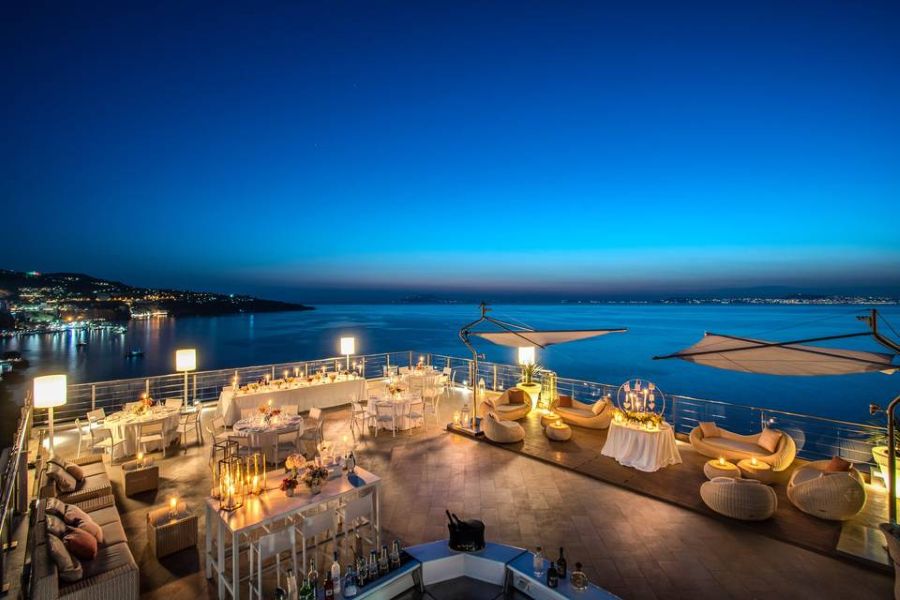
Sorrento’s nightlife sparkles with energy across its historic center. Piazza Tasso fills up after sunset as both locals and tourists mingle at outdoor cafes and wine bars. The streets stay lively until late, with plenty of people wandering between venues.
Positano takes a more laid-back approach once the sun goes down. Small cocktail bars tucked into the hillside offer stunning sea views. The vibe stays pretty chill – perfect for sipping an Aperol Spritz while watching the moon reflect off the Mediterranean.
Music and Dancing

Sorrento’s clubs and bars pump out everything from Italian pop to international hits. Dancing spots like Club Fauno Notte keep the party going until 3 AM. Live music fills many bars, with local musicians playing traditional songs and modern covers.
Positano’s music scene stays more intimate. A few select bars feature acoustic performers or jazz musicians. The Music on the Rocks disco, built into a cave above the sea, stands out as the town’s main dancing venue.
Romantic Spots and Views
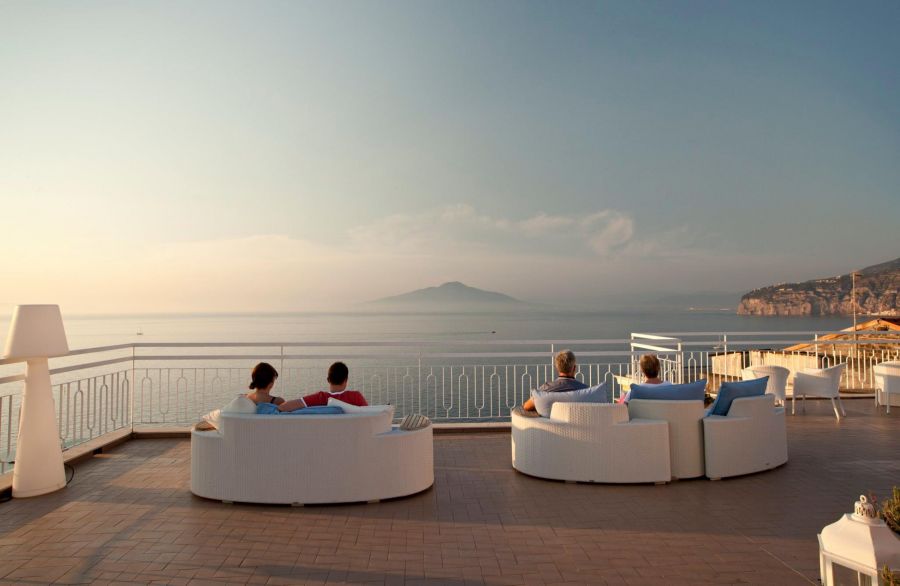
Both towns shine for couples seeking magical evenings. In Sorrento, rooftop bars like Sky Bar serve craft cocktails with views stretching to Mount Vesuvius. Waterfront restaurants along Marina Grande create perfect date night settings.
Positano’s Le Sirenuse champagne bar offers front-row seats to the twinkling village lights. Franco’s Bar serves creative drinks on a terrace that seems to float above the sea. Many hotels open their panoramic bars to the public for sunset cocktails.
Cultural Experiences and Sightseeing
Both Sorrento and Positano offer rich cultural heritage mixed with stunning coastal views. Each town brings unique artistic traditions, historical landmarks, and vibrant local festivities to life.
Historical Sites and Ruins
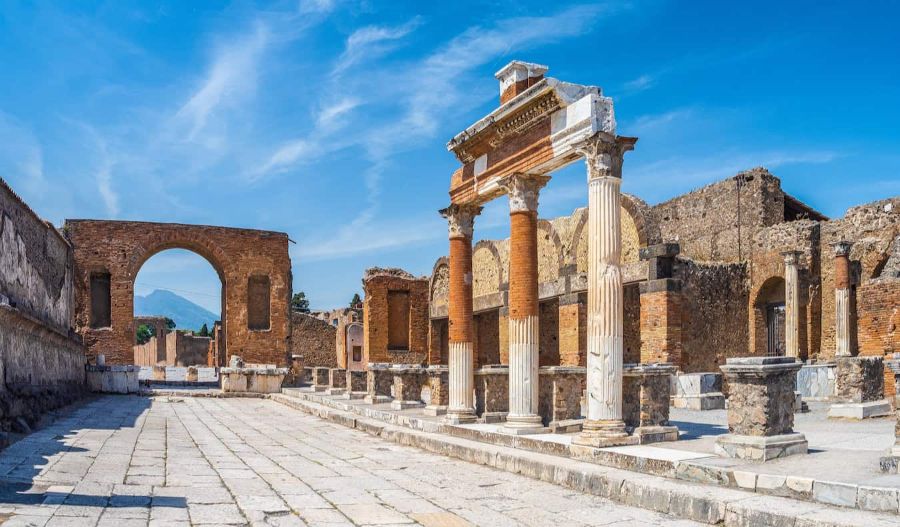
Sorrento serves as an ideal base for exploring ancient ruins. The famous ruins of Pompeii sit just 17 miles away, offering a glimpse into Roman life frozen in time by Mount Vesuvius’s eruption.
The Archaeological Museum in Sorrento displays Greek and Roman artifacts found in the region. Ancient Roman villa remains dot the countryside, showing the area’s importance during the Empire.
Positano’s history stretches back to medieval times. The Path of the Gods, an ancient trail connecting mountain villages, provides spectacular views while walking in the footsteps of ancient traders.
Churches and Architectural Marvels
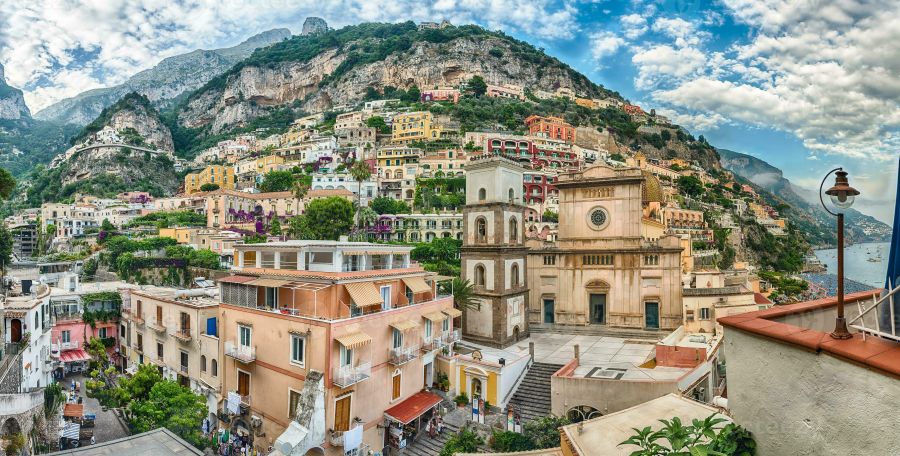
The Church of Santa Maria Assunta stands as Positano’s crown jewel, with its striking majolica-tiled dome visible from almost anywhere in town. The church houses a Byzantine Black Madonna icon from the 13th century.
Sorrento’s Cathedral, rebuilt in the 15th century, showcases beautiful marquetry work, a local artistic tradition. The Basilica of Sant’Antonino honors the town’s patron saint with remarkable baroque architecture.
Both towns feature narrow medieval streets lined with historic buildings. Positano’s vertical architecture creates a unique cascade of pastel-colored houses down the cliffside.
Museums and Galleries

Sorrento’s Correale Museum of Terranova displays local crafts, including the famous inlaid woodwork pieces made by local artisans. The museum also houses paintings from the 17th and 18th centuries.
The MAR Villa Fondi in Sorrento exhibits archaeological finds and hosts temporary art exhibitions. Local galleries showcase contemporary artists inspired by the coastal scenery.
Positano’s smaller museum scene focuses on Roman villa ruins beneath the Church of Santa Maria Assunta. Art galleries feature works by local painters who capture the town’s iconic views.
Festivals and Events

Sorrento celebrates the Feast of Sant’Anna in July with boat processions and fireworks. The town comes alive during Holy Week with religious processions and traditional ceremonies.
Summer in Positano brings the Dance Festival, featuring performances against the backdrop of the sea. Local food festivals celebrate regional specialties like lemons and seafood.
Both towns host classical music concerts in historic churches and outdoor venues. Christmas seasons feature living nativity scenes and traditional celebrations that transform the narrow streets into festive wonderlands.
Outdoor Adventures and Nature
The stunning landscapes of Sorrento and Positano offer endless opportunities for outdoor exploration. Both towns serve as perfect bases for active travelers who want to discover the natural wonders of the Amalfi Coast.
Scenic Hiking Trails

The most famous trek is the Path of the Gods, an ancient trail connecting mountain villages with breathtaking views of the coastline. The path stretches 4.3 miles between Agerola and Nocelle, offering panoramic vistas of Capri and the Mediterranean Sea.
Ancient stone paths wind through fragrant lemon groves near Sorrento. These peaceful trails showcase the region’s agricultural heritage and provide stunning views of Mount Vesuvius across the Bay of Naples.
Local guides lead group hikes that explain the fascinating geology and history of the trails. Spring and fall offer the best hiking weather, with mild temperatures and clear skies.
Coastal Walks and Explorations

A scenic clifftop walk connects Sorrento’s town center to Marina Grande, passing historic villas and hidden coves. The path offers excellent photo spots of the fishing village below.
The walk from Positano to the neighboring village of Montepertuso reveals hidden grottos and ancient watchtowers. Along the way, small beaches and rocky outcrops provide perfect rest stops.
Ravello’s terraced gardens showcase some of the coast’s most spectacular viewpoints. The Villa Cimbrone and Villa Rufolo gardens offer peaceful walking paths among blooming flowers and centuries-old trees.
Water Sports and Activities
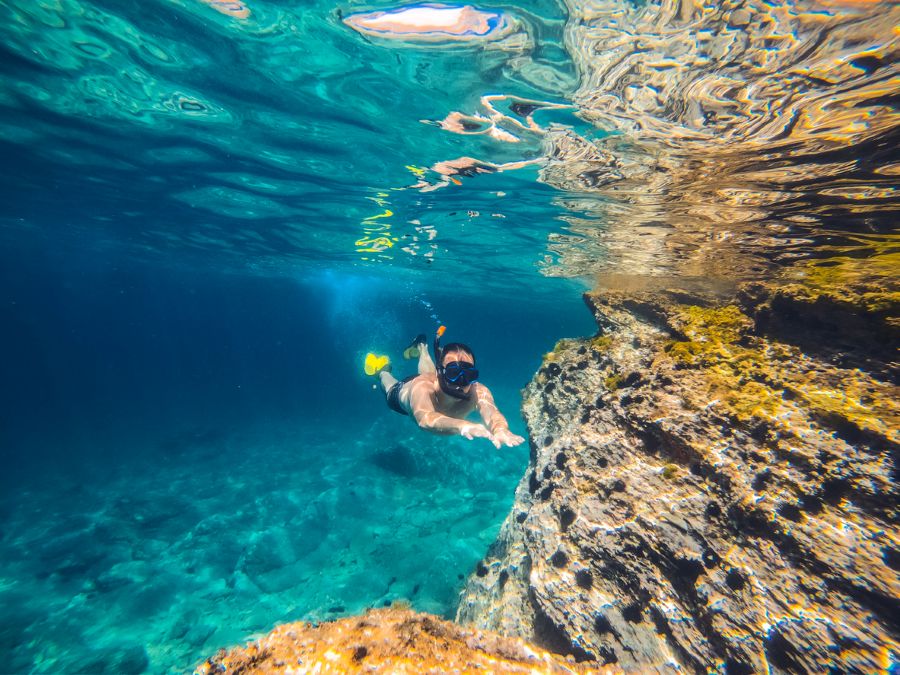
Boat tours depart daily from both towns, exploring sea caves and secluded beaches. Kayaking trips allow closer exploration of the dramatic coastline and hidden coves.
Positano’s main beach offers paddleboard rentals and lessons for beginners. The calm morning waters provide ideal conditions for learning.
Snorkeling spots near Sorrento reveal colorful marine life among the rocks. Local diving centers arrange trips to underwater caves and Roman ruins.
Stand-up paddleboarding at sunset has become increasingly popular. The evening light creates magical reflections on the water while paddling along the coast.
Planning Your Visit
Timing your visit and choosing the right travel style makes a big difference when visiting Sorrento or Positano. Both towns have distinct peak seasons, travel considerations, and costs that impact the experience.
Best Time to Travel
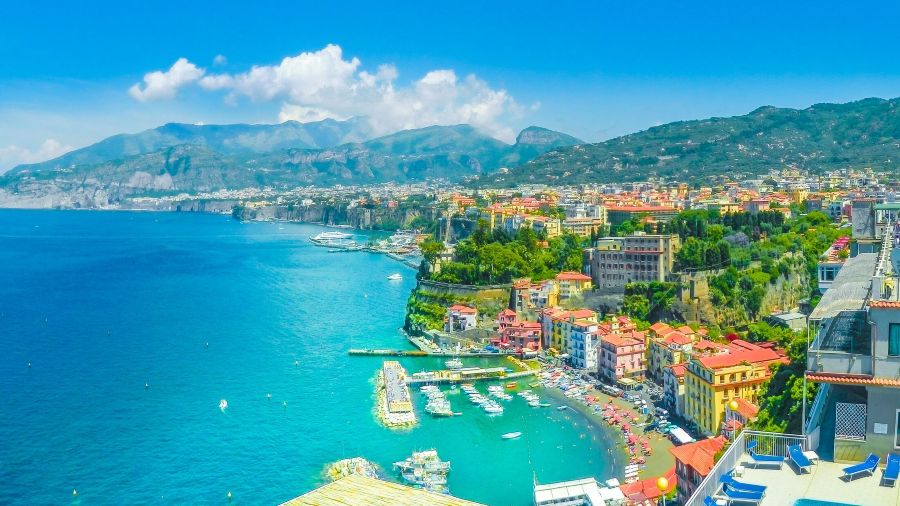
Spring (April-May) and fall (September-October) offer the best weather and fewer crowds in both towns. Temperatures stay mild, ranging from 65-75°F, perfect for exploring.
Summer brings intense heat and massive tourist crowds. Hotel prices spike by 40-50% between June and August. The beaches get packed, and restaurants often require reservations.
Winter sees fewer visitors but many businesses close, especially in Positano. Sorrento stays more active year-round with its larger local population.
Travel Style and Itineraries
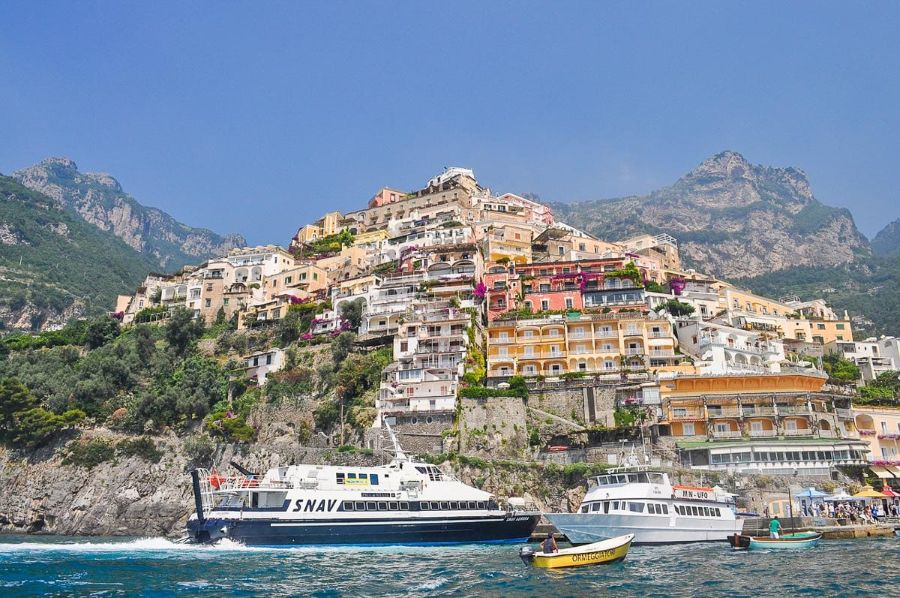
Sorrento works better for first-time visitors and families. The flat town center makes it easier to navigate with kids or mobility issues. Good public transport links help with day trips.
Positano suits romantic getaways and photography enthusiasts. The vertical layout means lots of stairs but creates those iconic coastal views. A car helps but parking is limited.
Stay at least 3 nights in either town to properly explore. Many visitors split their time between both places for different experiences.
Budgeting for the Trip
Average Daily Costs per person:
- Budget: €80-120
- Mid-range: €150-250
- Luxury: €300+
Positano tends to cost 20-30% more than Sorrento for hotels and dining. Budget travelers find more options in Sorrento with its wider range of accommodations.
Save money by visiting in shoulder season, eating at local spots away from main squares, and using public transport instead of taxis. Many beaches charge entry fees – research free public areas.
Frequently Asked Questions
People often ask about choosing between these two beautiful Italian coastal towns – each has unique features that make them special. Location, beaches, and transportation all play important roles in planning a perfect trip.
What are the main differences between Sorrento and Positano in terms of tourist attractions?
Sorrento offers a bustling town center with Piazza Tasso as its heart. The square features many cafes and shops selling local specialties like limoncello and handmade ceramics.
Positano focuses more on coastal charm with its colorful houses cascading down the cliffside. The town’s narrow streets hide boutiques selling custom sandals and linen clothing.
Which destination is preferable for a day trip, Sorrento or Positano, and why?
Sorrento works better for day trips because of its easier access to public transportation. The train station connects directly to Naples and Pompeii.
The town’s flat center makes exploring easier in a short time frame. You can see the main sights without climbing too many stairs.
How does the nightlife compare between Sorrento and Positano?
Sorrento has more bars and entertainment venues that stay open late. The streets around Piazza Tasso come alive at night with music and people.
Positano offers a quieter evening scene. Most activity centers around hotel bars and upscale restaurants with sea views.
From a logistical standpoint, what should one consider when choosing between staying in Sorrento or Positano?
Sorrento sits on flatter ground with better public transportation links. The town has more hotels at different price points and easier access to groceries and services.
Positano requires more planning with its steep streets and steps. Getting luggage to hotels can be tricky, and taxis cost more here.
How do the beach experiences differ between Sorrento and Positano?
Sorrento’s Marina Grande features pebbly beaches with clear water. The beaches are smaller and sit below the town’s dramatic cliffs.
Positano’s main beach has dark sand and pebbles with rows of colorful umbrellas. The water stays shallow longer, making it good for families.
What are the travel options for getting from Sorrento to Positano, and which is most recommended?
The SITA bus runs regularly between both towns. The journey takes about 45 minutes along the coastal road.
Ferry service operates in summer months. It’s more expensive than the bus but offers amazing views of the coastline.
A private driver provides the most flexible option. They can stop at viewpoints along the way and avoid parking hassles.


